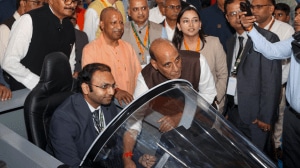The Trainer will come on time
On its way to hosting the worlds largest workforce,India by 2020 will also see one of the biggest and most innovative skill development efforts.
On its way to hosting the worlds largest workforce,India by 2020 will also see one of the biggest and most innovative skill development efforts.
India will have the worlds largest working population by 2030,and by the end of 2020,this trend will be clear. The downside: the next decade may see a shortage of skilled manpower. There can be an incremental shortfall of around 240 million skilled people by 2020 in 21 critical sectors of the economy. The national target is to skill 500 million persons by 2022.
Is it possible to bridge this gap? Yes. During the next decade,we are likely to see a dramatically different job and skill development scenario.
There is a quiet revolution taking place nationwide. Young people working with blue-chip companies,large corporates,experienced business leaders,NGOs and even overseas training organisations are leading initiatives or heading to India to set up skill development organisations.
Not new,you might say,and recall the number of charities and organisations that are training hundreds or even thousands. But look again,and you would notice that these organisations have plans to skill hundreds of thousands,even millions,in the next 10 years,and that too not through Corporate Social Responsibility (CSR) projects,aid or charity,but by creating new business models.
These organisations,which are scripting a new chapter in the space of social entrepreneurship,would perhaps emerge as the largest training and skill development organisations worldwide. The good news is that they would be Indian organisations. It is likely that the next NR Narayana Murthy or Azim Premji is in the making as you read this piece!
The entrepreneurs are seeking to bridge the demand-supply gap that currently exists and do it in a manner that is trainee-centric,and meets employer needs. This would lead to a demand-driven skill development model as against the current supply-driven format. Organisations would assess the needs of society,employer and entrepreneur,and devise courses and deliver these in a manner that makes institutions sustainable and independent of grants,aid or charity.
These would be inclusive organisations enabling any person with no or any qualification to join,undergo a skill development programme and get a job (or enhanced recognition in the existing job) or come back for more programmes creating perhaps one of the largest applications for use of the Aadhar number.
Organisations like Gram Tarang are looking at transforming the job and skill landscape in the most difficult terrain,providing in situ opportunities for the youth in Orissa and Andhra Pradesh,or working to skill people in Jammu and Kashmir,as in the case of B-Able.
Many others are setting up facilities in the rural heartland Iskill in over 150 agricultural mandis,and B-Able and Workskills India in over 700 centres impart skills that would enable local youth to get jobs to add value to the local economy. For example,teaching people how to boost cattle productivity or increase output from the local kirana store.
Pratham,an NGO in the field of education,intends to move from village to village,address the demand in one habitation before moving on to the next,and return after some time to skill a new set and up-skill others. The Confederation of Real Estate Developers Associations of India (CREDAI) is using mobile training units to skill people at construction sites. Infrastructure Leasing & Financial Services Limited is setting up 100 mini-ITIs in rural clusters. Others are seeking to extend the FabIndia model to revive the dying arts and crafts of India.
Those like Empower,IIJT and Domesteq are seeking to organise the unorganised: by training and placing drivers,domestic workers,and carpenters,for example. Lets take the journey of a domestic help in the kitchen. After work,he could join a short duration course to teach him how to cook. After the course,he could add value at home or be eligible to become an assistant to a chef. He could also do his basic education through the open schools system; and over a period of time,accumulate enough credits to qualify to get a diploma.
Technology is set to play a disruptive role. Simulators such as those for driving (Maruti),forklift operators (Saint Gobain) and welders (Everonn) have made an appearance. Other skills and trades would follow,reducing training costs. Use of existing infrastructure like the five lakh telecom towers and citizen service centres,and the use of mobile hand-held devices,including mobile projectors (INTEX- NSDC) which will be used to deliver training would become a reality. Digital content would become India-centric and create a large support industry. Skill development could be the next killer application for 3G/4G or WIMAX applications in India.
Industry should and most probably will set up large skill development centres. NGOs should and most likely will scale up their training initiatives. The Centre and states must fiscally support skill development vouchers for trainees may become the big government innovation of this decade.
This is a possible reality. Almost all the elements are in place. We need to work together as a nation to complete the ecosystem and become the skills capital of the world.
The author is CEO and MD,National Skill Development Corporation
& The Last Decade
NREG Did the Job
Hunting for the big idea of the last decade is easiest when it comes to job creation. The National Rural Employment Guarantee (NREG) is the obvious candidate. Renamed MNREG in 2009 (M for Mahatma Gandhi),this national welfare scheme,the brainchild of the National Advisory Council,has been called the largest employment programme of all times.
The Basics
NREG was conceived as a people-centric,demand-driven,and rights-based programme aimed at providing 100 days of guaranteed employment every year to each rural household seeking work. It began in February 2006 in the 200 most underdeveloped districts of the country. It was extended countrywide over 2008-09. Between 2007-08 and 2009-10,NREG has provided 600 crore man-days of work to poor rural Indians. The total government expenditure on the programme has so far been Rs 70,000 crore.
The Design
The programme was aimed at creating basic infrastructure that would be locally useful. Priority was given to work related to water harvesting,groundwater recharge,drought-proofing,etc. The levels of skill required were minimal. This led to the criticism that NREG de-prioritised outcome,that public resources were being spent on projects of little value even to locals.
Report Card
Not only did state-level performances vary widely,but some of the laggards were surprising. Left-ruled Bengal and Kerala came towards the bottom in the NREG score card,as did BJP-ruled Gujarat. The national average of days of work provided was 48,less than half the 100 days promised. And the performance was below the national average in 14 states. Nationally,only 14 per cent of the households covered in NREG received the 100 days of work . Fake muster rolls and jobs being commandeered by the rural elite are major problems.
Plug the Leak
Social audit by voluntary organisations did reduce the amount of leakage in NREG. The UID project is expected to plug it further. NREG will be one of the few last-decade ideas that will continue to get plenty of attention and scrutiny.
Priyadarshi Siddhanta



- 01
- 02
- 03
- 04
- 05




























